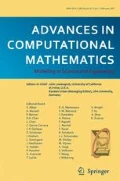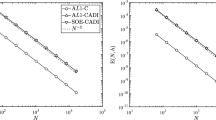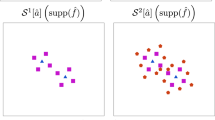Abstract
Consider a linear elliptic PDE defined over a stochastic stochastic geometry a function of N random variables. In many application, quantify the uncertainty propagated to a quantity of interest (QoI) is an important problem. The random domain is split into large and small variations contributions. The large variations are approximated by applying a sparse grid stochastic collocation method. The small variations are approximated with a stochastic collocation-perturbation method and added as a correction term to the large variation sparse grid component. Convergence rates for the variance of the QoI are derived and compared to those obtained in numerical experiments. Our approach significantly reduces the dimensionality of the stochastic problem making it suitable for large dimensional problems. The computational cost of the correction term increases at most quadratically with respect to the number of dimensions of the small variations. Moreover, for the case that the small and large variations are independent the cost increases linearly.
Similar content being viewed by others
References
Adams, R.A.: Sobolev spaces. Academic Press, New York (1975)
Bäck, J., Nobile, F., Tamellini, L., Tempone, R.: Stochastic spectral Galerkin and collocation methods for PDEs with random coefficients: a numerical comparison. In: J.S. Hesthaven, E.M. Rønquist (eds.) Spectral and High Order Methods for Partial Differential Equations, Lecture Notes in Computational Science and Engineering, vol. 76, pp. 43–62. Springer, Berlin (2011)
Barthelmann, V., Novak, E., Ritter, K.: High dimensional polynomial interpolation on sparse grids. Adv. Comput. Math. 12, 273–288 (2000)
Billingsley, P.: Probability and Measure, 3rd edn. Wiley, New York (1995)
Brookes, M.: The matrix reference manual. http://www.ee.ic.ac.uk/hp/staff/dmb/matrix/calculus.html (2017)
Castrillon-Candas, J., Nobile, F., Tempone, R.: Analytic regularity and collocation approximation for PDEs with random domain deformations. Comput. Math. Appl. 71(6), 1173–1197 (2016)
Castrillón-Candás, J., Xu, J.: A stochastic collocation approach for parabolic pdes with random domain deformations. Computers & Mathematics with Applications (2021)
Chauviere, C., Hesthaven, J., Lurati, L.: Computational modeling of uncertainty in time-domain electromagnetics. SIAM J. Sci. Comput 28, 751–775 (2006)
Chernov, A., Schwab, C.: First order k − th moment finite element analysis of nonlinear operator equations with stochastic data. Math. Comput. 82(284), 1859–1888 (2013)
Chkifa, A., Cohen, A., Schwab, C.: High-dimensional adaptive sparse polynomial interpolation and applications to parametric pdes. Found. Comput. Math. 14(4), 601–633 (2014). https://doi.org/10.1007/s10208-013-9154-z
Dambrine, M., Greff, I., Harbrecht, H., Puig, B.: Numerical solution of the poisson equation on domains with a thin layer of random thickness. SIAM J. Numer. Anal. 54(2), 921–941 (2016)
Dambrine, M., Greff, I., Harbrecht, H., Puig, B.: Numerical solution of the homogeneous neumann boundary value problem on domains with a thin layer of random thickness. J. Comput. Phys. 330, 943–959 (2017). https://doi.org/10.1016/j.jcp.2016.10.044. http://www.sciencedirect.com/science/article/pii/S0021999116305484
Dambrine, M., Harbrecht, H., Puig, B.: Computing quantities of interest for random domains with second order shape sensitivity analysis. ESAIM: M2AN 49(5), 1285–1302 (2015)
Fransos, D., Stochastic numerical methods for wind engineering. Ph.D. thesis, Politecnico di Torino (2008)
Gerstner, T., Griebel, M.: Dimension-adaptive tensor-product quadrature. Comput. 71(1), 65–87 (2003)
Gohberg, I.: Holomorphic operator functions of one variable and applications : methods from complex analysis in several variables. Operator theory : advances and applications. Birkhauser, Basel (2009)
Guignard, D., Nobile, F., Picasso, M.: A posteriori error estimation for the steady Navier-Stokes equations in random domains. Comput. Meth. Appl. Mech. Eng. 313, 483–511 (2017). https://doi.org/10.1016/j.cma.2016.10.008. http://www.sciencedirect.com/science/article/pii/S0045782516301803
Harbrecht, H., Peters, M., Siebenmorgen, M.: Analysis of the domain mapping method for elliptic diffusion problems on random domains. Numer. Math. 134(4), 823–856 (2016)
Harbrecht, H., Schmidlin, M.: Multilevel quadrature for elliptic problems on random domains by the coupling of fem and bem (2018)
Harbrecht, H., Schneider, R., Schwab, C.: Sparse second moment analysis for elliptic problems in stochastic domains. Numer. Math. 109, 385–414 (2008)
van den Hout, M., Hall, A., Wu, M.Y., Zandbergen, H., Dekker, C., Dekker, N.: Controlling nanopore size, shape and stability. Nanotechnology 21 (2010)
Klimke, A. Sparse Grid Interpolation Toolbox – user’s guide. Tech. Rep. IANS report 2007/017, University of Stuttgart (2007)
Klimke, A., Wohlmuth, B.: Algorithm 847: spinterp: Piecewise multilinear hierarchical sparse grid interpolation in MATLAB. ACM Trans. Math. Soft. 31(4) (2005)
Kober, V., Alvarez-Borrego, J.: Karhunen-Loève expansion of stationary random signals with exponentially oscillating covariance function. Opt. Eng. (2003)
Nobile, F., Tamellini, L., Tempone, R.: Convergence of quasi-optimal sparse-grid approximation of Hilbert-space-valued functions: application to random elliptic pdes. Numer. Math. 134(2), 343–388 (2016). https://doi.org/10.1007/s00211-015-0773-y
Nobile, F., Tempone, R., Webster, C.: An anisotropic sparse grid stochastic collocation method for partial differential equations with random input data. SIAM J. Numer. Anal. 46(5), 2411–2442 (2008)
Nobile, F., Tempone, R., Webster, C.: A sparse grid stochastic collocation method for partial differential equations with random input data. SIAM J. Numer. Anal. 46(5), 2309–2345 (2008)
Scarabosio, L.: Multilevel Monte Carlo on a high-dimensional parameter space for transmission problems with geometric uncertainties. ArXiv e-prints (2017)
Smolyak, S.: Quadrature and interpolation formulas for tensor products of certain classes of functions. Soviet Math., Dokl. 4, 240–243 (1963)
Stacey, A.: Smooth map of manifolds and smooth spaces. http://www.texample.net/tikz/examples/smooth-maps/
Tamellini, L., Nobile, F.: Sparse grids matlab kit (2009-2015). http://csqi.epfl.ch/page-107231-en.html
Tartakovsky, D., Xiu, D.: Stochastic analysis of transport in tubes with rough walls. J. Comput. Phys. 217(1), 248 – 259 (2006). Uncertainty quantification in simulation science
Zhenhai, Z., White, J.: A fast stochastic integral equation solver for modeling the rough surface effect computer-aided design. In: IEEE/ACM International Conference ICCAD-2005, pp. 675–682 (2005)
Funding
This material is based upon work supported by the National Science Foundation under Grant No. 1736392. Research reported in this technical report was supported in part by the National Institute of General Medical Sciences (NIGMS) of the National Institutes of Health under award number 5R01GM131409-03.
Author information
Authors and Affiliations
Corresponding author
Additional information
Communicated by: Anthony Nouy
Publisher’s note
Springer Nature remains neutral with regard to jurisdictional claims in published maps and institutional affiliations.
Rights and permissions
About this article
Cite this article
Castrillón-Candás, J.E., Nobile, F. & Tempone, R.F. A hybrid collocation-perturbation approach for PDEs with random domains. Adv Comput Math 47, 40 (2021). https://doi.org/10.1007/s10444-021-09859-6
Received:
Accepted:
Published:
DOI: https://doi.org/10.1007/s10444-021-09859-6




